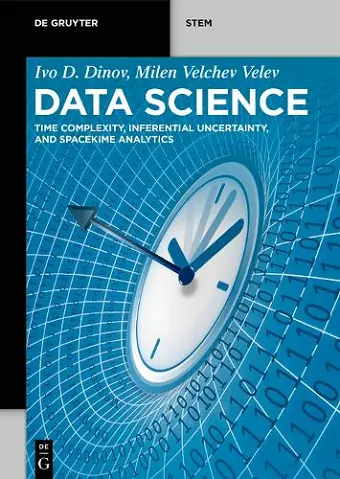Data Science
Time Complexity, Inferential Uncertainty, and Spacekime Analytics
Ivo D Dinov author Milen Velchev Velev author
Format:Hardback
Publisher:De Gruyter
Published:20th Dec '21
Should be back in stock very soon

The amount of new information is constantly increasing, faster than our ability to fully interpret and utilize it to improve human experiences. Addressing this asymmetry requires novel and revolutionary scientific methods and effective human and artificial intelligence interfaces.
By lifting the concept of time from a positive real number to a 2D complex time (kime), this book uncovers a connection between artificial intelligence (AI), data science, and quantum mechanics. It proposes a new mathematical foundation for data science based on raising the 4D spacetime to a higher dimension where longitudinal data (e.g., time-series) are represented as manifolds (e.g., kime-surfaces). This new framework enables the development of innovative data science analytical methods for model-based and model-free scientific inference, derived computed phenotyping, and statistical forecasting. The book provides a transdisciplinary bridge and a pragmatic mechanism to translate quantum mechanical principles, such as particles and wavefunctions, into data science concepts, such as datum and inference-functions. It includes many open mathematical problems that still need to be solved, technological challenges that need to be tackled, and computational statistics algorithms that have to be fully developed and validated.
Spacekime analytics provide mechanisms to effectively handle, process, and interpret large, heterogeneous, and continuously-tracked digital information from multiple sources. The authors propose computational methods, probability model-based techniques, and analytical strategies to estimate, approximate, or simulate the complex time phases (kime directions). This allows transforming time-varying data, such as time-series observations, into higher-dimensional manifolds representing complex-valued and kime-indexed surfaces (kime-surfaces).
The book includes many illustrations of model-based and model-free spacekime analytic techniques applied to economic forecasting, identification of functional brain activation, and high-dimensional cohort phenotyping. Specific case-study examples include unsupervised clustering using the Michigan Consumer Sentiment Index (MCSI), model-based inference using functional magnetic resonance imaging (fMRI) data, and model-free inference using the UK Biobank data archive.
The material includes mathematical, inferential, computational, and philosophical topics such as Heisenberg uncertainty principle and alternative approaches to large sample theory, where a few spacetime observations can be amplified by a series of derived, estimated, or simulated kime-phases. The authors extend Newton-Leibniz calculus of integration and differentiation to the spacekime manifold and discuss possible solutions to some of the "problems of time". The coverage also includes 5D spacekime formulations of...
ISBN: 9783110697803
Dimensions: unknown
Weight: 928g
489 pages